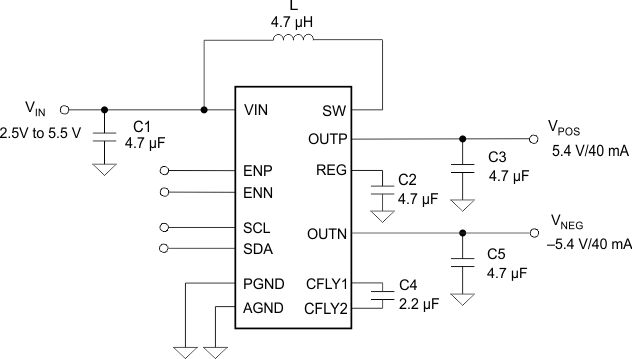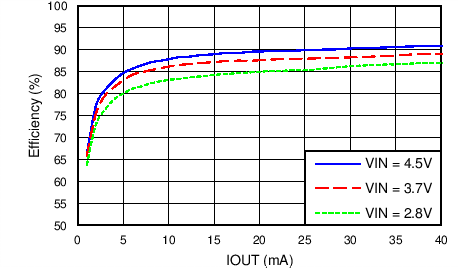SLVSBM1H June 2013 – November 2016 TPS65132 , TPS65132S
UNLESS OTHERWISE NOTED, this document contains PRODUCTION DATA.
- 1 Features
- 2 Applications
- 3 Description
- 4 Revision History
- 5 Device Comparison Table
- 6 Pin Configuration and Functions
- 7 Specifications
- 8 Detailed Description
-
9 Application and Implementation
- 9.1 Application Information
- 9.2
Typical Applications
- 9.2.1
Low-current Applications (≤ 40 mA)
- 9.2.1.1 Design Requirements
- 9.2.1.2 Detailed Design Procedure
- 9.2.1.3 Application Curves
- 9.2.2
Mid-current Applications (≤ 80 mA)
- 9.2.2.1 Design Requirements
- 9.2.2.2 Detailed Design Procedure
- 9.2.2.3 Application Curves
- 9.2.3 High-current Applications (≤ 150 mA)
- 9.2.1
Low-current Applications (≤ 40 mA)
- 10Power Supply Recommendations
- 11Layout
- 12Device and Documentation Support
- 13Mechanical, Packaging, and Orderable Information
1 Features
- Input Voltage Range: 2.5 V to 5.5 V
- VPOS Boost Converter:
4 V to 6 V (0.1-V step) - VNEG Inverting Buck-Boost Converter:
–6 V to –4 V (0.1-V step) - Maximum Output Current:
80 mA or 150 mA - Outstanding Combined Efficiency
- > 85% at IOUT > 10 mA
- > 90% at IOUT > 40 mA
- Excellent Performance
- Outstanding Transient Response
- 1% Output Voltage Accuracy over
Full Temperature Range
- I2C Interface
- Programmable Power-Up / -Down
Sequencing Options - Flexible Output Voltage Programming
- Programmable Active Output Discharge
- > 1000x Programmable Non-Volatile Memory
- Programmable Power-Up / -Down
- Under-Voltage Lock-Out and Thermal Protection
- Two Package Options
- 15-Ball CSP Package
- 20-Pins QFN Package
2 Applications
- Small-, Medium-Size Bipolar LCD Displays
- Smartphone, Tablet
- Camera, GPS
- Home Automation, Point-of-Sales
- Wearables (Smart Watch, Activity Tracker)
- General Split-Rail Power Supply
- Differential Audio, Headphone Amplifier
- Instrumentation, Operational Amplifier, Comparator
- DAC / ADC
3 Description
The TPS65132 family is designed to supply positive/negative driven applications. The device uses a single inductor scheme for both outputs to provide the user smallest solution size, a small bill-of-material as well as high efficiency. The devices offer best line and load regulation at low noise. With its input voltage range of 2.5 V to 5.5 V, it is optimized for products powered by single-cell batteries (Li-Ion, Ni-Li, Li-Polymer) and fixed 3.3-V and 5-V rails. The TPS656132 family provides 80 mA and 150 mA output current options with programmability to 40 mA. There are both CSP and QFN package options available.
Device Information (1)
| PART NUMBER | PACKAGE | BODY SIZE (NOM.) |
|---|---|---|
| TPS65132 -B, -L, -T, -S |
DSBGA (15) | 2.11 mm × 1.51 mm |
| TPS65132W | WQFN (20) | 4.00 mm × 3.00 mm |
- For all available packages, see the orderable addendum at the end of the datasheet.
space
space
Typical Application

Efficiency vs Output Current
